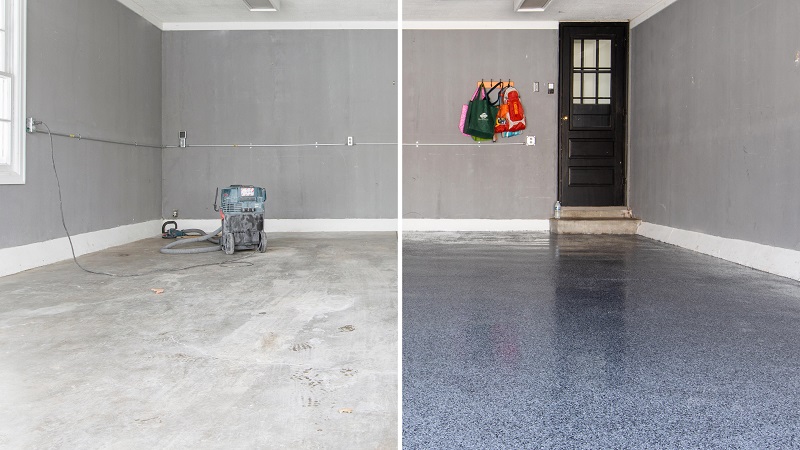Which Primer Coat is Best for Your Concrete Floor: Epoxy or Polyaspartic?

When it comes to coating your concrete floor, selecting the right primer is a crucial step that can significantly impact the overall performance and longevity of your flooring system. Epoxy and polyaspartic are two popular choices for primer coats on concrete, each with its unique characteristics and benefits. In this blog post, we will compare and contrast epoxy and polyaspartic primers, helping you determine which one is better suited for your specific needs. We will also discuss the importance of adhesion to concrete and how to ensure that your primer coat provides a strong bond for a successful flooring installation.
Understanding Epoxy Primer
Epoxy primer is a tried and true option for concrete flooring, valued for its exceptional adhesion and durability. It is a two-part system that combines epoxy resin with a hardener, resulting in a chemical reaction that creates a tough, protective layer. Epoxy primers are known for their ability to penetrate the concrete surface, forming a strong bond that prevents peeling and delamination.
Pros of Epoxy Primer:
- Excellent Adhesion: Epoxy primers offer outstanding adhesion to concrete, ensuring a reliable bond between the substrate and the subsequent layers of the flooring system.
- Chemical and Stain Resistance: Epoxy primers are highly resistant to chemicals, oils, and stains, making them suitable for areas with frequent spills or potential exposure to harsh substances.
- Durability: Once cured, epoxy primers create a durable surface that can withstand heavy foot traffic, impact, and abrasion.
- Versatile: Epoxy primers are compatible with various topcoats, such as epoxy and polyurethane, allowing you to customize the final appearance and performance of your concrete floor.
Cons of Epoxy Primer:
- Longer Cure Time: Epoxy primers typically have a longer cure time compared to polyaspartic primers, which may extend the overall project timeline.
- Temperature Sensitivity: The curing process of epoxy primers can be affected by temperature fluctuations, so proper climate control is essential during installation.
Exploring Polyaspartic Primer
Polyaspartic primer is a relatively newer option in the world of concrete coatings, gaining popularity for its rapid cure time and exceptional UV stability. Polyaspartic primers are also two-part systems, combining polyaspartic resin with a hardener, and they have gained recognition for their ability to reduce downtime during installation.
Pros of Polyaspartic Primer:
- Fast Cure Time: Polyaspartic primers cure rapidly, often within a few hours, which can significantly reduce the time required for flooring installation and minimize downtime.
- UV Stability: Polyaspartic primers are highly resistant to UV rays, making them suitable for outdoor applications or areas with exposure to direct sunlight.
- Chemical Resistance: Similar to epoxy, polyaspartic primers also offer excellent chemical resistance, ensuring protection against spills and stains.
- High Build Coating: Polyaspartic primers can be applied at a higher thickness, resulting in a high build coating that can help level uneven concrete surfaces.
Cons of Polyaspartic Primer:
- Short Pot Life: Polyaspartic primers have a shorter pot life compared to epoxy, meaning they must be applied quickly after mixing, requiring careful planning during installation.
- Skill-Dependent Application: The rapid cure time of polyaspartic primers demands skilled application to achieve a smooth and even coating.
Importance of Adhesion to Concrete
Regardless of whether you choose epoxy or polyaspartic primer, proper adhesion to the concrete substrate is crucial for a successful flooring installation. Without a strong bond, the subsequent layers of the flooring system may delaminate, resulting in costly repairs and compromised performance.
To ensure optimal adhesion, proper surface preparation is essential. The concrete surface should be thoroughly cleaned, free of any contaminants, and mechanically profiled to create a rough surface. This allows the primer to penetrate and bond effectively with the concrete.
Additionally, understanding the specific requirements of your chosen primer is crucial. Some primers may require a specific concrete moisture content, while others may necessitate a primer coat with additional grit for improved bonding.
Choosing the Right Primer for Your Needs
Ultimately, the decision between epoxy and polyaspartic primer depends on your specific project requirements and priorities. Consider the following factors when making your choice:
- Cure Time: If you need a quick turnaround for your project, polyaspartic primer may be the preferred option due to its rapid cure time.
- UV Exposure: For outdoor applications or areas with direct sunlight exposure, polyaspartic primer’s UV stability makes it a more suitable choice.
- Chemical Resistance: Both epoxy and polyaspartic primers offer excellent chemical resistance, but the specific chemicals present in your environment may influence your decision.
- Durability: Epoxy primers are renowned for their long-term durability and exceptional adhesion, making them a reliable choice for high-traffic areas.
- Expertise and Skill: The application of polyaspartic primers requires skilled professionals due to their fast cure time, while epoxy primers offer a more forgiving application process.
Conclusion
Choosing the right primer coat for your concrete floor is a critical decision that will impact the performance and longevity of your flooring system. Both epoxy and polyaspartic primers have their unique strengths and benefits, and understanding their characteristics can help you make an informed choice. Consider factors such as cure time, UV stability, chemical resistance, and the expertise required for installation when selecting the best primer for your needs. Additionally, prioritize proper surface preparation to ensure a strong bond between the primer and the concrete substrate. By selecting the appropriate primer and entrusting the installation to skilled professionals, you can achieve a resilient and visually appealing concrete floor that will stand the test of time.
